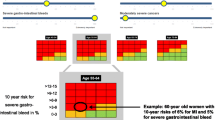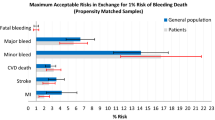Abstract
OBJECTIVE: To investigate whether patients are influenced by the order in which they learn the risks and benefits of a treatment and whether this effect is attenuated by a treatment’s associated risk and/or benefit.
DESIGN: Subjects were randomized to review 1 of 6 medical treatment information brochures.
SETTING: Waiting rooms of primary care physicians at an academic health center.
PARTICIPANTS: Six hundred eighty-five subjects, ages 18 to 70 years.
INTERVENTION: Subjects reviewed 1 of 3 treatments for symptomatic carotid artery disease. The first (aspirin) was low-risk/low-benefit, the second (carotid endarterectomy surgery) was high-risk/high-benefit, and the third (extracranial-to-intracranial bypass surgery) was high-risk but of unknown benefit. Patients were also randomized to receive information about risk either before or after benefit. Patients were asked to rate the favorability of the treatment on a scale of 0 to 100 and whether they would consent. Finally, subjects rated how their decisions were influenced by the risk and benefit information.
MAIN RESULTS: Subjects evaluating aspirin therapy were influenced by the order of the risk/benefit information. Those learning about risks after benefits had a greater drop in their favorability ratings than subjects learning about risks before benefits (−10.9 vs −5.2 on a 100-point scale; P=.02) and were less likely to consent (odds ratio, 2.27; P=.04). In contrast, subjects evaluating carotid endarterectomy and extracranial-to-intracranial bypass were not influenced by information order. When subjects were influenced by the order of information, they also reported that the treatment’s risk had less influence on their decision making (P<.01).
CONCLUSIONS: When patients evaluate low-risk medical interventions, they may form less favorable impressions of the treatment and be less likely to consent to the treatment when they learn about the risks after the benefits. Order effects were not observed with high-risk treatments regardless of potential benefits.
Similar content being viewed by others
References
Hogarth RM, Einhorn HJ. Order effects in belief updating: the belief-adjustment model. Cognit Psychol. 1992;24:1–55.
Strang KR, Schwei M, Geiselman RE. Effects of the structure of descriptions on group impression formation. Bull Psychosom Soc. 1978;12:224–26.
Schadewald MS, Limberg ST. Effect of information order and accountability on causal judgments in a legal context. Psychol Rep. 1992;71:619–25.
Adelman L, Bresnick T, Black PK, Marvin FF, Sak SG. Research with Patriot air defense officers—examining information order effects. Hum Factors. 1996;38:250–61.
Tubbs RM, Gaeth GJ, Levin IP, Van Osdol LA. Order effects in belief updating with consistent and inconsistent evidence. J Behav Decis Making. 1993;6:257–69.
Bergus GR, Chapman GB, Gjerde C, Elstein AS. Clinical reasoning about new symptoms despite pre-existing disease: sources of error and order effects. Fam Med. 1995;27:314–20.
Chapman GB, Bergus GR, Elstein AS. Order of information affects clinical judgment. J Behav Decis Making. 1996;9:201–11.
Bergus GR, Chapman GB, Levy BT, Ely JW, Oppliger RA. Clinical diagnosis and the order of information. Med Decis Making. 1998;18:412–17.
Bergus GR, Levin IP, Johnson C. The influence of information order on patient decision making. Med Decis Making. 1998;18:460.
Grubb RL Jr., Derdeyn CP, Fritsch SM, et al. Importance of hemodynamic factors in the prognosis of symptomatic carotid occlusion. JAMA. 1998;280:1055–60.
Collaborative overview of randomised trials of antiplatelet therapy-I. Prevention of death, myocardial infarction, and stroke by prolonged antiplatelet therapy in various categories of patients. Antiplatelet Trialists’ Collaboration. BMJ. 1994;308:81–106.
North American Symptomatic Carotid Endarterectomy Trial Collaborators. Beneficial effect of carotid endarterectomy in symptomatic patients with high-grade carotid stenosis. N Engl J Med. 1991;325:445–53.
Guadagnoli E, Ward P. Patient participation in decision-making. Soc Sci Med. 1998;47:329–39.
Kahneman D, Tversky A. Prospect Theory: an analysis of decision under risk. Econometrica. 1979;47:263–91.
Smith SM, Levin IP. Need for cognition and choice framing effects. J Behav Decis Making. 1996;9:283–90.
Sanbonmatsu DM, Kardes FR. The effects of physiologic arousal on information processing and persuasion. J Consum Res. 1988;15:379–85.
Pham MT. Cue representation and selection effects of arousal on persuasion. J Consum Res. 1996;22:373–87.
Miller JM, Krosnick JA. The impact of candidate name order on election outcomes. Public Opin Q. 1998;62:291–330.
Wang H, Zhang J, Johnson TR. Human belief revision and order effect. Proceedings of the 22th Annual Conference of the Cognitive Science Society. 2000. Hillsdale, NJ: Erlbaum.
Instructions for the Use of Vaccine Information Statements. Available at: http://www.cdc.gov/nip/publications/vis/vis-Instructions.pdf, created 10/1/01. Accessed 01/06/02.
Lopes LL. Procedural debiasing. Acta Psychol (Amst). 1987;64:167–85.
Wang H. Order Effects in Human Belief Revision. Dissertation. Columbus, Ohio: The Ohio State University; 1998.
Author information
Authors and Affiliations
Corresponding author
Rights and permissions
About this article
Cite this article
Bergus, G.R., Levin, I.P. & Elstein, A.S. Presenting risks and benefits to patients. J GEN INTERN MED 17, 612–617 (2002). https://doi.org/10.1046/j.1525-1497.2002.11001.x
Issue Date:
DOI: https://doi.org/10.1046/j.1525-1497.2002.11001.x




